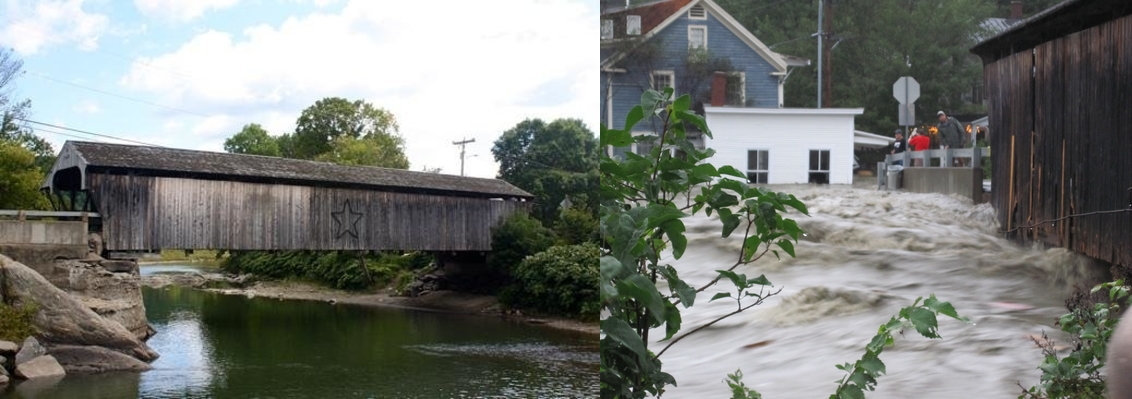Introduction
The chief purpose of hydraulic engineering is to design a structure with the proper capacity to pass collected water under the roadway. The design of a hydraulic structure requires knowing how much water will pass through the crossing at a design storm of interest (hydrology) and using that information to calculate the velocity, depth, and type of flow that must be accounted for in the design (hydraulics). A properly designed structure will consider constructability based on local site constraints and be sized in accordance with State of Vermont hydraulic and environmental standards.

Figure 1: Waitsfield, VT Covered Bridge after (left) and during (right) Tropical Storm Irene in August 2011. Debris carried downstream by the floodwaters of the Mad River caused visible damage to the structure, requiring the replacement of several side panels. As there is not sufficient freeboard at this magnitude event, the hydraulic capacity of the stream was limited by the opening beneath this structure. Understanding the impact of bridges on floodwaters is an essential component of hydraulic design.
Functional Classification
Each roadway is given a functional classification based on ownership and traffic usage. This classification corresponds to a design event based on the probability of annual occurrence. For example, a design rainfall event of 4% annual equivalence probability (AEP), means that in a given year, an event of this magnitude has a 4% chance of occurring. Statistically, an event with a 4% chance of occurring each year, will have a return interval of 25 years. The following design events, detailed in Hydraulics Manual Table 4-2, correspond to the associated roadway classifications:
- 1% - Freeways
- 2% - Principal and minor arterials, major and minor collectors, railroad crossings
- 4% - Local roads and streets
More Information: Hydraulics Manual, Section 6.4.2.1: Allowable Headwater and Backwater

Figure 2: Woolen Mill of Winooski, VT during the historic flood of 1927. USGS historical archives detail flow in this event to have exceeded the 0.2% AEP. Floodwaters of this magnitude have a 0.2% chance of occurring in any given year and a statistical return interval of 500 years. It should be noted that in the years since this historic event, several flood control structures have been built on the Winooski River, reducing the probability associated with an event of this magnitude. By contrast, the 2011 flooding from T.S. Irene resulted in flows below the 10% AEP at this location.
Resources
The VTrans Hydraulics Manual, published May 28, 2015, serves to identify approaches to analyzing road and highway hydraulics that are approved for use by VTrans. Please note that best management practices and state standards may be dynamic. For the most up to date information, please contact the regulatory agency of interest or the VTrans Hydraulics Unit.
The Federal Emergency Management Agency (FEMA) has an online map service center available for acquisition of Flood Insurance Study (FIS) information. If there is a FIS at the crossing of interest, the structure is subject to FEMA foodway and floodplain management regulations for backwater.
The Watershed Management Division of the Vermont Agency of Natural Resources (ANR) has a series of publications related to river management, including the following:
- The Vermont Standard River Management Principles and Practices (SRMPP).
- The E-stone specification is available in the associated appendices, Appendix M.
- Stream Alteration Rules and General Permit
More resources are detailed in Hydraulics Manual, Section 3.6: Data Sources and Section 3.7: Data Tools.
Nature of this Material
Continued development of statewide experience, introduction of new legislation, application of innovative technology and the response to research findings, embody the reason that design standards and best management practices are in a constant state of refinement.
This material is intended as informal guidance and is considered a living document. The most up to date information should be used to select the appropriate structure for any site. For more information on current standards and practices, navigate the links in the Resource section above, or contact Nick Wark, VTrans Hydraulics Engineer at Nick.Wark@vermont.gov.
This material was last updated on April 16th, 2018.
Previous page: AOT Hydraulics
Next Page: Design Criteria and Standards
